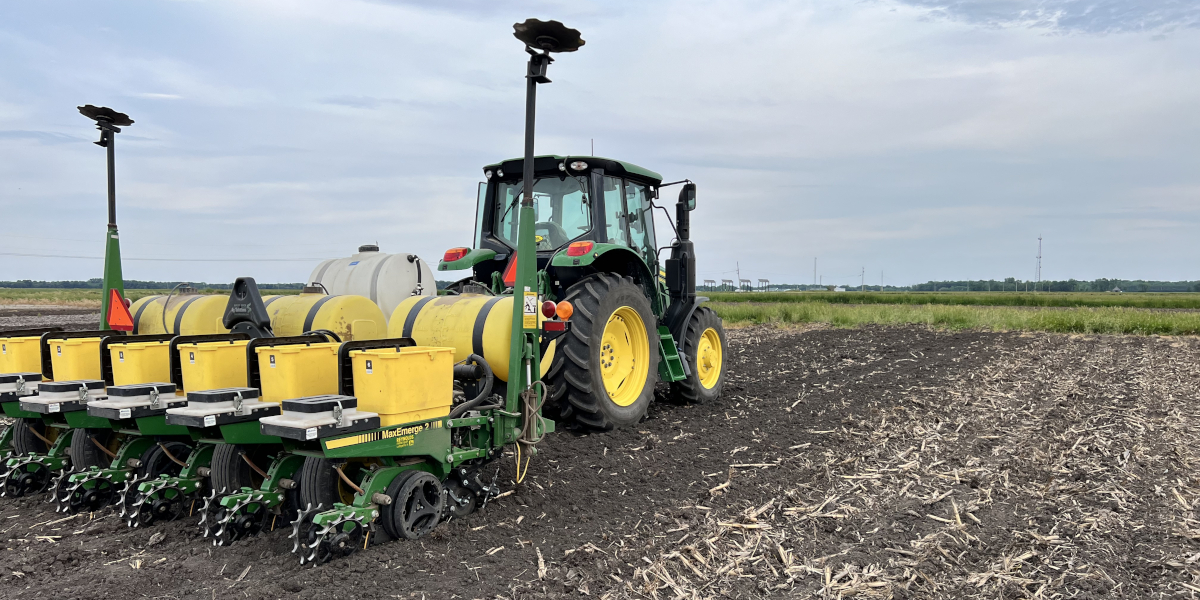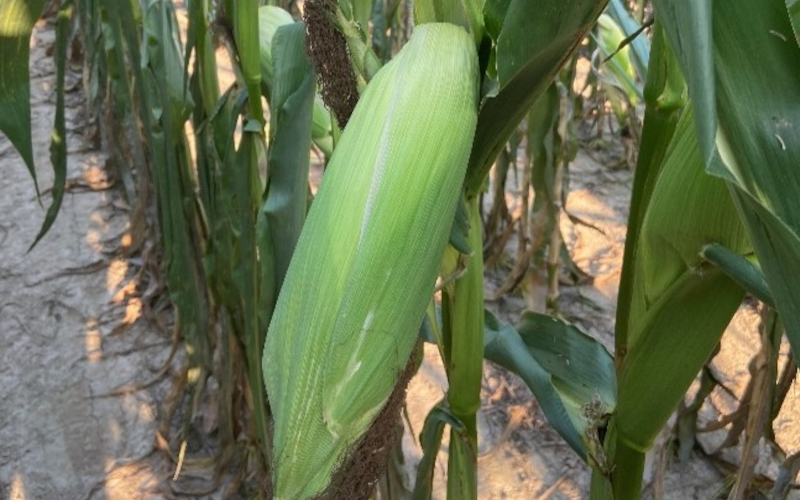The majority of the corn across the state of Indiana has either just entered the dent growth stage (R5) or has already been in the dent stage as it approaches physiological maturity (R6, black layer). Once corn reaches R5, there can be a preconceived notion that we are now home free if any stress were to occur, and that grain yield has been made. However, it is still important to understand the importance of this final growth stage of the corn plants life prior to reaching maturity, and why a significant amount of grain yield is still being determined during this period.
The R5 growth stage in corn can occur approximately 30 – 40 days following silking and is defined when nearly all kernels are ‘dented’ at the crown of the kernel and hard starch or solid endosperm has begun to form (Abendroth et al., 2011; Larson, 2018) (Figure 1). The ‘dent’ at the kernel top is a result of starch content increasing and moisture content decreasing within the kernel (Abendroth et al., 2011).

Figure 1. Appearance of kernel dent at the beginning R5 growth stage in a white corn hybrid.
The R5 growth stage of corn takes about 30-33 calendar days and approximately 337 to 360 growing degree days (GDDs) to complete and can depend on hybrid maturity (Brown, 1999; Abendroth et al., 2011; Nielsen, 2021). Corn also advances much quicker through the beginning stages of R5 compared to the later stages of R5 (Table 1). Understanding and staging the progression of the R5 growth stage in corn is determined through the identification of the milk line (Figure 2). The milk line is the line within the kernel that separates the solid endosperm and liquid endosperm. As the corn plant approaches maturity, more moisture is lost from the kernel, and the milk line progresses toward the cob. Identifying the milk line is important for understanding 1) what is my approximate kernel moisture, 2) what is my approximate kernel dry matter accumulation, and 3) how much time do I have left until corn reaches maturity? (Table 1). Milk line progression can also help gauge when irrigation should be terminated.
Table 1. Kernel moisture percentage, kernel dry matter percentage, and approximate calendar days for milk line progression during the R5 growth stage of corn (Abendroth et al., 2011).
r5 growth stage progression| R Stage | % Grain Moisture | Kernel Dry Matter (% of Total Dry Weight) |
Calendar Days |
| 5.0 | 60% | 45% | 3 |
| 5.25 (1/4 Milk Line) | 52% | 65% | 6 |
| 5.5 (1/2 Milk Line) | 40% | 90% | 10 |
| 5.75 (3/4 Milk Line) | 37% | 97% | 14 |
| 6.0 (Physiological Maturity) | 35% | 100% |

Figure 2. Solid endosperm, liquid endosperm, and milk line appearance in corn during the R5 growth stage.
What is important about the R5 growth stage in terms of grain yield is specific to the amount of kernel dry matter accumulation that is occurring during this stage. At the beginning of the R5 growth stage, even though corn is getting close to maturity, percent total kernel dry weight is only 45% (Table 1; Abendroth et al., 2011). This means that there is still approximately 50 to 55% kernel dry weight left to be accumulated. Therefore, if significant environmental stress (drought, nutrient deficiency, etc.) were to occur during beginning R5, significant yield losses can still occur. Kernel weight is a major yield component for corn, and achieving excellent grain fill and maximum kernel weight is important for achieving high corn yields. Previous research has shown that complete plant death from frost, or complete leaf loss at beginning R5 can reduce corn yield by approximately 41 and 27%, respectively (Carter and Hesterman, 1990). However, once corn has reached half milk line, approximately 90% of kernel dry matter has been accumulated and yield losses may only be 5 to 10%. The importance of kernel weight can also be highlighted when performing yield checks in your fields using the yield component estimation method (Nielsen, 2021). The “fudge factors” used to estimate corn grain yield are based on kernel weight or the number of kernels per 56 lb bushel. The most common number used is 90 or 90,000 kernels per 56 lb bushel. However, using a range from 65 (heavy kernels) to 105 (light kernels) can give you an indication of the importance of kernel weight for yield and the impacts environmental stresses can have during corn grain fill.
It is important to remember that although corn has reached the R5 growth stage, there is still a significant amount of yield left to be made. Factors such as photosynthetic leaf area loss, high temperatures, drought, premature ear drooping, termination of irrigation too early, nutrient deficiencies, foliar diseases, and insect damage can still impact corn yield at R5 by limiting the amount of carbohydrates provided by the plant and reducing kernel weight. However, these yield losses can drastically decrease as the milk line progresses and the corn plant approaches maturity. Therefore, it is still important to be scouting and walking your fields later in the season, pulling some ears, and understanding where the milk line is at to determine what potential impacts environmental stresses may have and how much longer until that corn plant reaches maturity.
References
Abendroth, L.J., R.E. Elmore, M.J. Boyer, and S.K. Marlay. 2011. Corn growth and development. Iowa State Univ. Extension publication PMR1009.
Carter, P.R., and O.B. Hesterman. 1990. Handling corn damaged by autumn frost (NCH-57). Purdue Univ. Extension. https://www.extension.purdue.edu/extmedia/NCH/NCH-57.html.
Larson, E. 2018. Identifying corn reproductive growth stages and management implications. Mississippi State Univ. Extension. https://www.mississippi-crops.com/2018/07/05/identifying-corn-reproductive-growth-stages-and-management-implications/
Nielsen, R.L. 2002. Risk of fall frost injury to immature corn grain. Corny News Network. Purdue Univ. Extension. https://www.agry.purdue.edu/Ext/corn/news/articles.02/Grain_Maturation_Frost-0910.pdf
Nielsen, R.L. 2021. Grain fill stages in corn. Corny News Network, Purdue Univ. Extension. https://www.agry.purdue.edu/ext/corn/news/timeless/GrainFill.html





